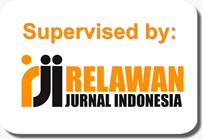FINANCIAL DISTRESS PREDICTED BY CASH FLOW AND LEVERAGE WITH CAPITAL INTENSITY AS MODERATING
Abstract
Keywords: CashFlow, Leverage, Capital Intensity, Financial distress
Full Text:
PDFReferences
DeFond, M. L., & Hung, M. (2003). An empirical analysis of analyst’s cash flow forecasts. Journal of Accounting and Economics, 35(1), 73–100. https://doi.org/10.1016/S0165-4101(02)00098-8
Desmawati, Kamaliah, & Wijaya, E. Y. (2016). Analisis Prediksi Kebangkrutan dengan Model Altman, Springate, Grover & Zmijewski pada Industri Manufaktur di BEI. Jurnal Tepak Manajemen Bisnis, Viii(2), 1–19.
Djongkang, F., & Rita, M. R. (2014). Manfaat Laba Dan Arus Kas Untuk Memprediksi Kondisi Financial Distress, (Sancall).
Fahmi, I. (2014). Pengantar Manajemen Keuangan. Bandung: Penerbit Alfabeta.
Irsanti, S. W. (2017). Pengembangan Media Pembelajaran Ekonomi Berbasis Video Untuk Meningkatkan Minat dan Prestasi Belajar Siswa Kelas X IPA 2 Tahun Ajaran 2016/2017.
Julius, F. (2017). Pengaruh Financial Leverage, Firm Growth, Laba dan Arus Kas Terhadap Financial Distress (Studi Empiris pada Perusahaan Manufaktur yang Terdaftar di Bursa Efek Indonesia Tahun 2010-2014). JOM Fekon, 1164–1178.
Kariani, N. P. E. K. K., & Budiasih, I. G. A. N. (2017). Firm Size Sebagai Pemoderasi Pengaruh Likuiditas , Leverage , Dan Operating Capacity Pada Financial Distress. E-Jurnal Akuntansi Universitas Udayana, 20(3), 2187–2216.
Kasmir. (2017). Analisis Laporan Keuangan. Jakarta: PT.RajaGrafindo Persada.
Kementrian Badan Usaha Milik Negara Republik Indonesia. (2017). Kementerian BUMN.
Kusanti, O., & Andayani. (2015). Pengaruh Good Corporate Governance Dan Rasio Keuangan Terhadap Financial Distress. Jurnal Ilmu & Riset Akuntansi, 4(10), 1–22.
Lee, S., Koh, Y., & Kang, K. H. (2011). International Journal of Hospitality Management Moderating effect of capital intensity on the relationship between leverage and financial distress in the U . S . restaurant industry. International Journal of Hospitality Management, 30(2), 429–438. https://doi.org/10.1016/j.ijhm.2010.11.002
Mulyanti, D., & Priastari, R. (2018). Pengaruh struktur aktiva dan pertumbuhan penjualan terhadap penentuan struktur modal, 35–40.
Nelmida, & Siregar, S. O. . (2016). Pengaruh Perubahan Penjualan , Capital Intensity Ratio , Debt to Asset Ratio , dan Current Ratio terhadap Cost Stickiness dalam Perusahaan di Bursa Efek Indonesia. Jurnal Ekonomi, Manajemen Dan Perbankan, 2(1), 1–10.
Novietta, L., & Minan, K. (2017). Komparasi Model Kebangkrutan Pada Perusahaan Tekstil dan Garmen yang Terdaftar di Bursa Efek Indonesia. Jurnal Akuntansi Dan Bisnis, 3(1), 118–143.
Nugraha, A., & Fajar, C. M. (2018). Financial Distress pada PT Panasia Indo Resources Tbk. Jurnal Inspirasi Bisnis Dan Manajemen, 2(1), 29–42.
Pourali, M. R., Samadi, M., & EnsiehKarkani. (2013). The study of relationship between capital intensity and financial leverage with degree of financial distress in companies listed in Tehran Stock Exchange, 4(12), 3830–3839.
Prihanthini, N. M. E. D., & Sari, M. M. R. (2013). Analisis Prediksi Kebangkrutan Dengan Model Grover, Altman Z-Score, Springate Dan Zmijewski Pada Perusahaan Food And Beverage Di Bei, 3, 544–560.
Ramadhiani, A. (2017). Berikut 6 Anggota “Holding” BUMN Perumahan. Kompas.com. Retrieved from https://properti.kompas.com/read/2017/01/17/173000121/berikut.6.anggota.holding.bumn.perumahan
Rice. (2015). Altman Z-Score : Mendeteksi Financial Distress. Jurnal Wira Ekonomi Mikroskill, 5, 111–120.
Sari, N. L. K. M., & Putri, I. G. A. M. A. D. (2016). Kemampuan Profitabilitas Memoderasi Pengaruh Likuiditas Dan Leverage Terhadap Financial Distress. E-Jurnal Ekonomi Dan Bisnis Universitas Udayana, 10(5), 3419–3448.
Sayari, N., & Mugan, F. N. C. S. (2013). Cash Flow Statement as an Evidence for Financial Distress. Universal Journal of Accounting and Finance, 1(3), 95–103. https://doi.org/10.13189/ujaf.2013.010302
Shaheen, S., & Malik, Q. A. (2012). The Impact of Capital Intensity , Size of Firm And Profitability on Debt Financing In Textile Industry of Pakistan. Interdisciplinary Journal Of Contemporary Research In Business, 3(10), 1061–1066.
Simanjuntak, C., Titik, F., & Aminah, W. (2017). Pengaruh Rasio Keuangan Terhadap Financial Distress ( Studi Pada Perusahaan Transportasi Yang Terdaftar Di Bursa Efek Indonesia Selama 2011 - 2015 ). Fakultas Ekonomi Dan Bisnis, Universitas Telkom, 4(2), 1580–1587. Retrieved from https://repository.telkomuniversity.ac.id/pustaka/files/136783/jurnal_eproc/pengaruh-rasio-keuangan-terhadap-fin
Srikalimah. (2017). Pengaruh Profitabilitas, Likuiditas dan Leverage Dalam Memprediksi Financial Distress (Studi Empiris Pada Perusahaan Manufaktur yang Terdaftar di BEI Periode 2009-2013). Akuntansi Dan Ekonomi, 2(1). https://doi.org/ISSN: 2541-0180
Sugiyono. (2013). Metode Penelitian Bisnis. Bandung: Penerbit Alfabeta.
Sumiyati, Y. (2013). Peranan BUMN dalam Pelaksanaan Tanggung Jawab Sosial Perusahaan untuk Meningkatkan Kesejahteraan Rakyat, 20(3), 460–481.
Yustika, Y. (2015). Pengaruh Likuiditas, Leverage, Profitabilitas, Operating Capacity Dan Biaya Agensi Manajerial Terhadap Financial Distress (Studi Empiris pada Perusahaan Manufaktur yang Terdaftar di Bursa Efek Indonesia Tahun 2011-2013). JOM Fekon, 2(2), 1–15.
DOI: https://doi.org/10.31846/jae.v7i1.188
Refbacks
- There are currently no refbacks.

This work is licensed under a Creative Commons Attribution-NonCommercial-NoDerivatives 4.0 International License.
e-Jurnal Apresiasi Ekonnomi Indexed by:












